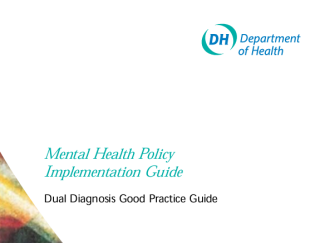Dual diagnosis good practice guide

Substance misuse is common among people with severe mental health problems, and mental health problems are common among those with substance misuse problems. This guide summarises policy and good practice for providing mental health services to people with severe mental health problems and problematic substance misuse.
- This guide summarises current policy and good practice in the provision of mental health services to people with severe mental health problems and problematic substance misuse. The substances concerned include legal and illegal drugs, alcohol and solvents, but not tobacco. It represents an addition to the Mental Health Policy Implementation Guide which supports implementation of the NSF for Mental Health. However, it differs somewhat in style and content from the rest of the implementation guide: it provides more detail on emerging policy, practice and the evidence base because service models for dual diagnosis are at an earlier stage of development.
- It is aimed at all those who commission and provide mental health and substance misuse services. Local Implementation Teams (LITs) are charged with implementing the policy requirements described in this guide, working in partnership with Drug Action Teams (DATs).
- Substance misuse is usual rather than exceptional amongst people with severe mental health problems and the relationship between the two is complex. Individuals with these dual problems deserve high quality, patient focused and integrated care. This should be delivered within mental health services. This policy is referred to as “mainstreaming”. Patients should not be shunted between different sets of services or put at risk of dropping out of care completely. “Mainstreaming” will not reduce the role of drug and alcohol services which will continue to treat the majority of people with substance misuse problems and to advise on substance misuse issues. Unless people with a dual diagnosis are dealt with effectively by mental health and substance misuse services these services as a whole will fail to work effectively.
- “Mainstreaming” will only work if the following policy requirements are delivered:
- local services must develop focused definitions of dual diagnosis which reflect local patterns of need and clarify the target group for services;
- these definitions must be agreed between relevant agencies;
- where they exist specialist teams of dual diagnosis workers should provide support to mainstream mental health services;
- all staff in assertive outreach teams must be trained and equipped to work with dual diagnosis;
- adequate numbers of staff in crisis resolution, early intervention, community mental health teams and inpatient services must also be suitably trained;
- all health and social care economies must map services and need;
- small and time limited local project teams including mental health and substance misuse specialists working to the LIT should prepare the focused definition together with care pathways and clinical governance guidelines;
- all services, including drug and alcohol services, must ensure that clients with severe mental health problems and substance misuse are subject to the Care Programme Approach and have a full risk assessment.
The guide summarises good practice in relation to assessment and treatment and sets out a programme for local implementation of the service model. It is concluded that integrated care – delivered by one team – appears to deliver better outcomes than serial care (sequential referrals to different services) or parallel care (more than one service engaging the client at the same time). However more UK based research is required and well organised parallel care can be used as a stepping stone to integration. Integrated treatment in this country can be delivered by existing mental health services following training and with support from substance misuse services.
